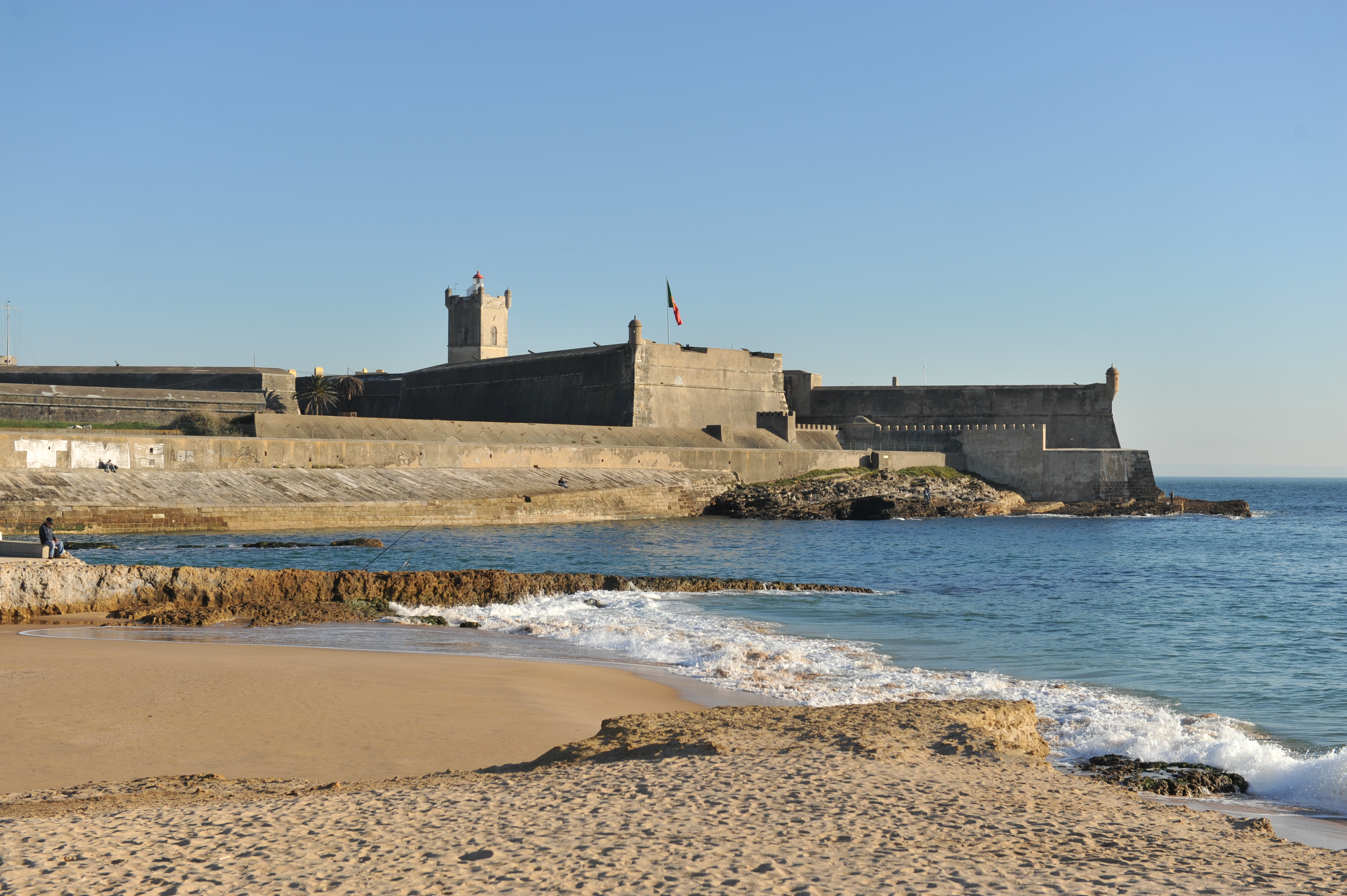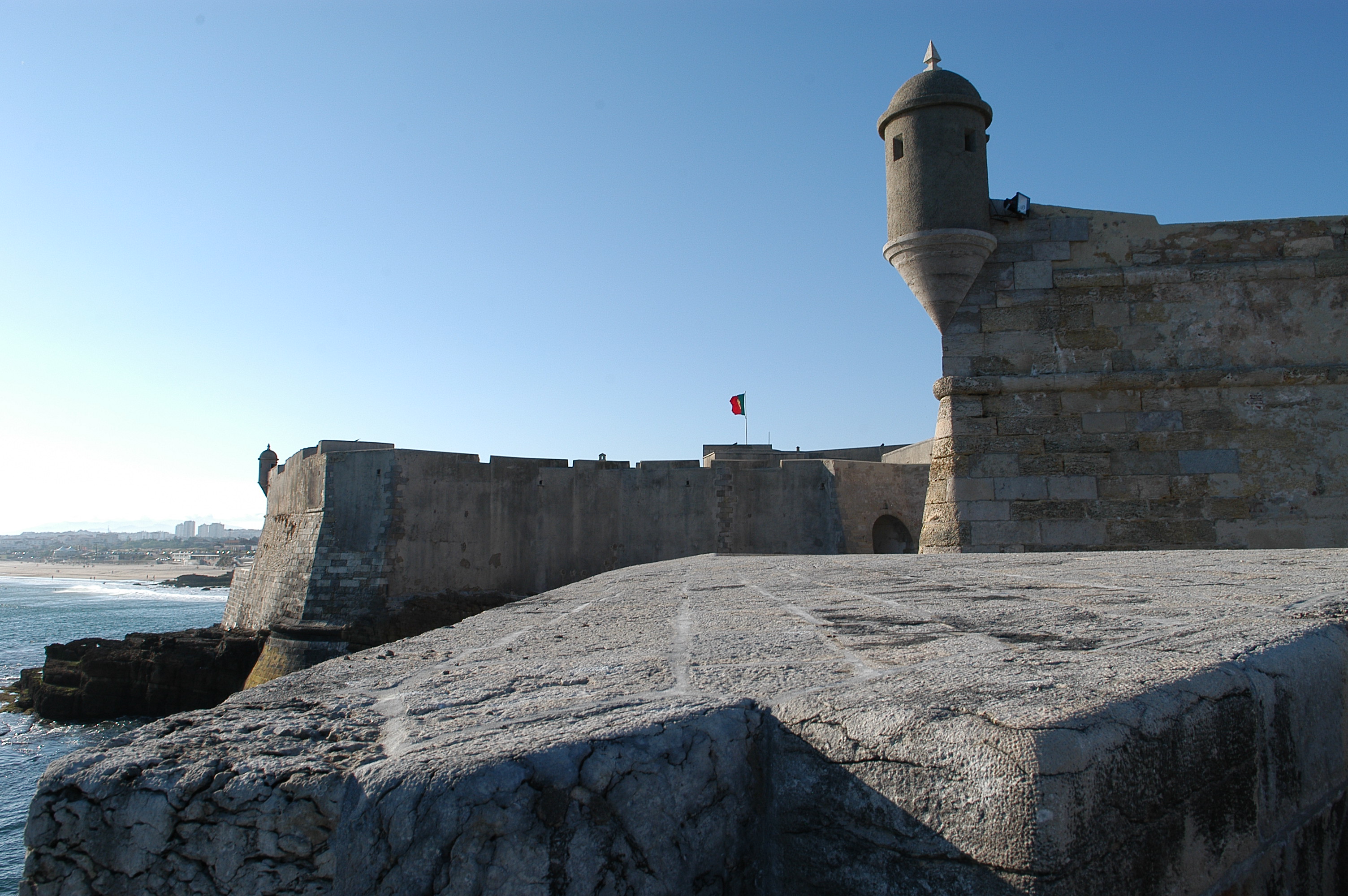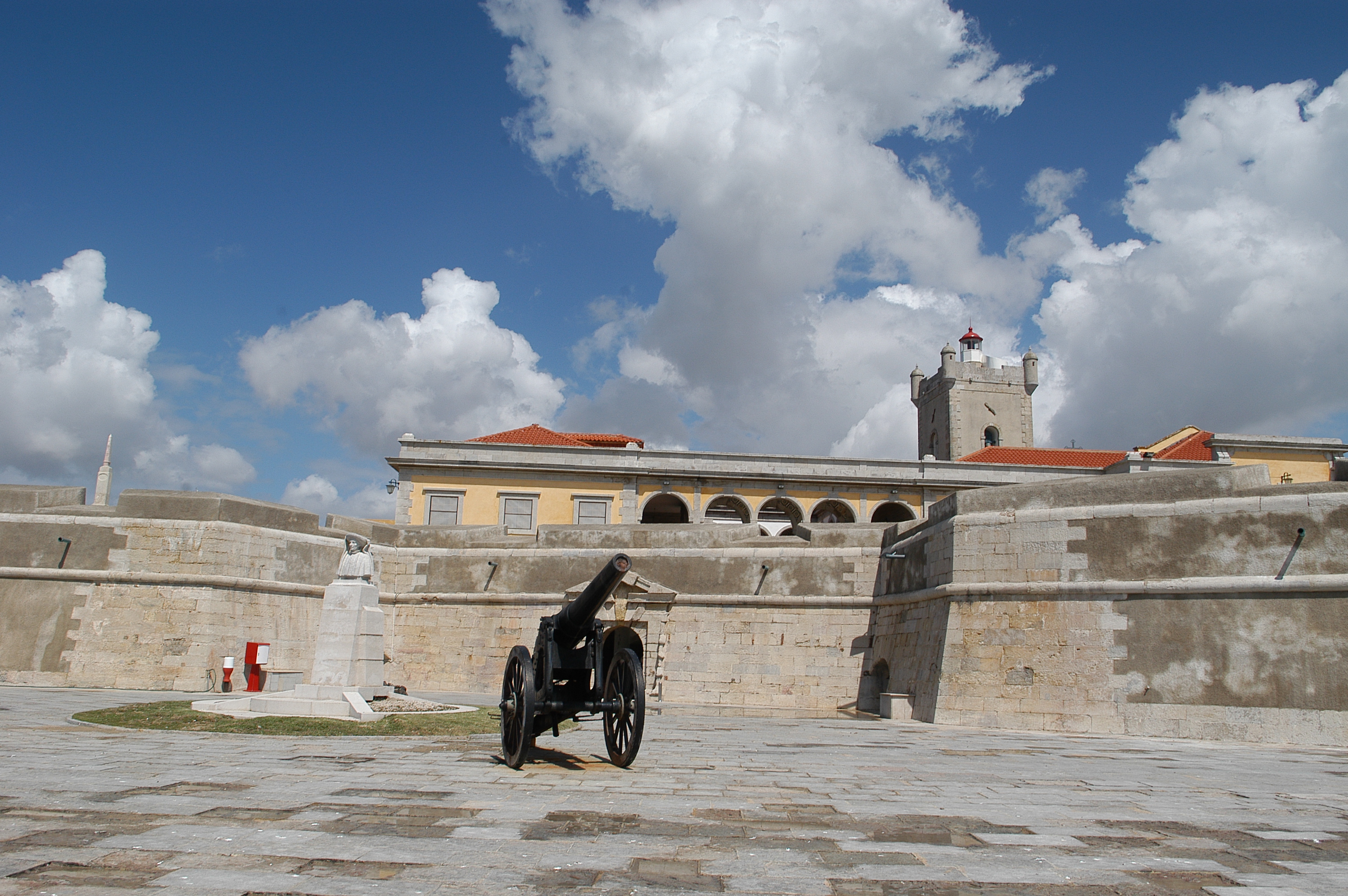Versão portuguesa aqui.
GPS 38.67480859407028, -9.325084639967715

The Fort of São Julião da Barra (formerly called Fort or Tower of São Gião) is the largest and most complete military defense complex in the Vauban style remaining in Portugal. It is located in São Julião da Barra, at the tip of São Gião, far west of Oeiras, in the parish of Oeiras and São Julião da Barra, Paço de Arcos and Caxias.
Considered in the past as the Shield of the Kingdom, the largest maritime fortification in the country. It originally had, together with the Fort of São Lourenço do Bugio, with whom it cooperated, the function of controlling the entry and exit of vessels in the Tagus bar and access to the port of Lisbon.
It is currently the official residence of the Minister of National Defense of Portugal.
History
Background
The construction of a fortification at the point where there would be a hermitage under the invocation of São Gião, on the right bank of the Tagus river bar, was recommended by King Manuel I (1495-1521) to his son and successor, John III ( 1521-1557).
In 1549, this sovereign created the position of Master of Fortification Works for the Kingdom, Lugares d'Além and Indies, which he entrusted to the renowned architect Miguel de Arruda, responsible for several fortified complexes in Portuguese overseas territories.
Given the understanding of his Council, which maintained that the maritime defense of the port of Lisbon should not be based solely on the Castle of São Jorge and the ancient Moorish fence, but on modern bastioned fortresses next to the mouth of the river, the sovereign started the work on the Forte da Ponta de São Gião in 1553, on the right bank of the Tagus bar.
The defense of the port and city of Lisbon would come to be constituted by a defensive complex integrated by the Tower, then Fort of São Lourenço do Bugio, on a sandbar in the middle of the mouth, with whom it crossed fires, closing the Tagus bar, complemented by the Fortress of Cascais, as an advanced guard on the right bank of the mouth, and by the Torre de Belém (right bank) and Torre Velha da Caparica (left bank) as the last defense of the port of Lisbon.

The Tower of Saint Julian
The plans for the original fortification, bastioned along the lines of the Italian school, are attributed to the architect Miguel de Arruda, in office created in 1549.
It is known that in 1559 a special tribute was paid, which allowed the building works to develop more quickly, and that in 1562 Miguel de Arruda was appointed Master-Vedor of the works. Thus, already in 1568, the structure was considered completed, at the end of the first regency of Cardinal D. Henrique (1562-1568). Complementary works, however, still continued in 1573, when in the fort's dungeons those who were awaiting exile were detained, engaged in forced labor in the works of the structure itself. Dates from that time (1579) a description and drawing of the fortification, by João Baptista Gésio, a spy in the service of King Philip II of Spain, who was already preparing to assume the throne of Portugal. Its defense, however, was not able to prevent the advance of Spanish troops under the command of the Duke of Alba who surrounded it on the land side, having surrendered after six days (August 13, 1580), according to negotiations between Tristão Vaz da Veiga and the command of the invading troops.
The period of the Philippine Dynasty
At the time of the Philippine Dynasty, from 1580 onwards, the Duke of Alba ordered the architect Giácomo Palearo to design means to reinforce the defense of the fort. The latter corrected the layout of the ditch, had new batteries erected, and expanded the defenses on the west flank. From 1582, the lower esplanade on the east side was built, adding the bulwarks named after São Filipe and São Pedro. From 1597 onwards, Leonardo Torriani, a military engineer and architect from Cremo, took over the direction of its expansion and reinforcement works. As a whole, these works transformed the Fort of São Julião into the largest and most powerful fortification in the kingdom of Portugal at the time. In the same period, the fortification facilities began to be used as a political prison of the Portuguese State, a function that was maintained in the following centuries until the 1st Portuguese Republic.

The Restoration of Portuguese Independence
At the time of the Restoration of Independence, it suffered its second land siege, now by troops loyal to the Duke of Bragança. On that occasion, the initiative of D. Fernando de Mascarenhas, 1st Count of Torre stood out, who, politically detained there, led the Spanish governor of the square, D. Fernando de La Cueva, to negotiate the terms of surrender, in exchange for a substantial reward. (December 12, 1640).
Under the reign of D. João IV (1640-56), the governor of the square, Martim Correia da Silva, reported to the sovereign the urgent need for repair work (1645). Thus, within a plan to reinforce the fortification of the Lisbon coast, from 1650 onwards, new expansion and reinforcement works took place in São Julião da Barra, with emphasis on the construction, on the land side, of a new ravelin, at the which would follow the construction of barracks and barracks for the garrison (1655).
The Pombaline Consulate
At the time of the Pombaline consulate, it underwent new works of recovery and expansion, now on the wall on the sea side, in the Governor's House, in the barracks and in the cisterns (1751). It suffered damage caused by the 1755 earthquake, the most serious perhaps the fall of the lighthouse, the respective tower that rose in the center of the square, according to contemporary sources (apud Memória do Pe. Matias Marques Cardoso in: Luís Cardoso (Pe.). Dicionário Portugal Geographic.). The repair work on the lighthouse involved raising its tower thirty palms in height (about six metres), and it returned to work in 1761. Meanwhile, the Prime Minister had more than a hundred Jesuits imprisoned there from 1759.
The 19th century
At the beginning of the Peninsular War, the French troops of Napoleon Bonaparte, under the command of General Jean-Andoche Junot reached the limits of Lisbon on November 30, 1807. The town of Oeiras and the Fort of São Julião were transformed into barracks. General of the French occupation troops under the command of General Jean-Pierre Travot, while the mouth of the Tagus River was blocked by the British navy. The fort only passed into British hands after the Convention of Sintra, on September 2, 1808.
From 1809, the Fort of São Julião, the most important of the line of Oeiras (which constituted the third of the four defensive lines of Lisbon, the famous Lines of Torres), once again had a Portuguese military governor. Under British guidance, a series of small marine redoubts were built on this coast to complement the land defense of São Julião, with the aim of protecting the re-embarkation of British troops in case of need.
In this period, continuously used as a political prison, one of its most famous detainees was General Gomes Freire de Andrade, accused of alleged involvement in a conspiracy against the British presence. Executed, his body was burned and his ashes thrown into the Tagus River on October 18, 1817.
During the Portuguese Civil War (1828-1834), it was the target of artillery fire from the French squadron which, under the command of Admiral Albin Roussin, forced the Tagus bar (1831).
The twentieth century
Having lost its defensive functions, in the face of the evolution of war means, but always occupied as a political prison and lighthouse, in the mid-twentieth century it was declassified as a military fortification and handed over to the presidency of the Council to be adapted for the reception of members of the government and inn of distinguished visitors (1951). Already in the exercise of these functions, it was used for the reception of the North American General Dwight David Eisenhower (1951) and that of the British Marshal Bernard Law Montgomery (1952), heroes of the Second World War (1939-1945).
From then on, the old barracks were adapted for civil use as lounges, dining room and library, with the Directorate-General for National Buildings and Monuments (DGEMN) initiating a long and careful series of consolidation and restoration interventions, in several campaigns (on its own in 1952-1954, 1962-1969, 1975, 1994-2000, and in partnership with IST/LNEC from 1998 to 2001).
Currently, it belongs to the State of National Defense. It is only open to the public by prior appointment and availability of the fort itself.
On November 12, 2012, the Portuguese Prime Minister, Pedro Passos Coelho, received the German Chancellor, Angela Merkel, at Fort São Julião da Barra at 1:35 pm, and the two spent five minutes talking outside the fortress. At the São Julião da Barra Fort, in Oeiras, Angela Merkel had a working lunch with Pedro Passos Coelho, which lasted an hour and a half, followed by a joint press conference, scheduled for 3 pm. Angela Merkel, who was coming from the Palace of Belém, where she was meeting with the President of the Republic, Cavaco Silva, arrived 15 minutes late at the Fort of São Julião da Barra, in Oeiras, where she had Pedro Passos Coelho waiting for her, alone. The Portuguese Prime Minister greeted the German Chancellor with a handshake and then the two walked calmly down the red carpet, chatting, stopping several times, until they reached a part of the fort's walls from where you can see, below, the Infant Square. In this square, in addition to a statue of Infante Dom Henrique, facing the mouth of the Tagus, there are two cannons bought in the 19th century from the Prussians. The menu for the working lunch between the Heads of Government of Germany and Portugal included poultry 'consommé' and Portuguese roast kid. Also participating in this meeting, representing the Portuguese Government, were the Minister of State and Foreign Affairs, Paulo Portas, the Assistant Secretary of State to the Prime Minister, Carlos Moedas, and the Secretary of State for Finance, Manuel Rodrigues. The Chancellor of Germany visited Portugal with a five-hour programme, which included meetings with the President of the Republic and the Portuguese Prime Minister and a meeting with businessmen from both countries.
Characteristics
The structure was built in stonework and plastered masonry, featuring an irregular plan with an approximately pentagonal shape, comprising walls, ravelin, bulwarks, esplanades with artillery batteries, covered watchtowers, walkways, ramps and others. Inside, in addition to the service facilities (Governor's House, troops' barracks, storerooms, warehouses and others), there was a chapel, vaulted casemates and a cistern in a circular segment, also vaulted, currently used as a reception hall. The lighthouse tower, with watchtowers on the corners, rises over three floors, flanked by the garrison quarters.
It is defended on the landward side by two moats and, formerly, by a drawbridge, currently in steel and masonry.
To the east stands the bastion of the Prince or King D. Fernando. To the west, facing the sea, there are other bastions, among which Santo António stands out.
Curiosities
In memory of Gomes Freire de Andrade, executed in 1817, a tombstone and an ashlar of tiles with his effigy were placed over the tower door.
One of the main items that can be appreciated by visitors are the Infante D. Henrique and Arrival of Vasco da Gama a Calicut tapestries, works signed by Jaime Martins Barata.
In 1989, during underwater archaeological surveys in the waters bordering the fort, two iron breastplates from the 17th century were found, possibly contemporary with the Restoration War.